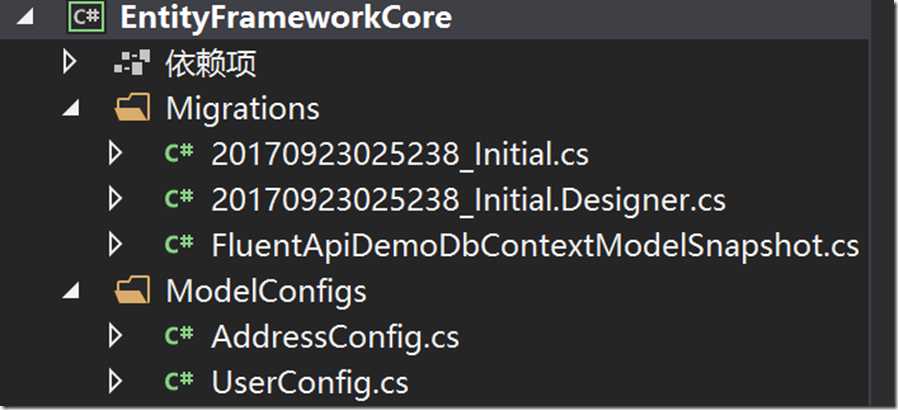.net core 2.0 Code First Fluent API配置
2021-05-12 04:29
标签:style lib ted 作者 err display 更改 kconfig void A.net core 2.0新特性支持通过IEntityTypeConfiguration添加Code First配置到一个封装类。 新建目标框架为.NET Core类库 新建完了以后右键点击程序集,选择属性,选择目标框架为.NET Core 2.0 在EntityFrameworkCore程序集中添加类User(用户)、Address(用户住址)、Book(书)、Author(作者)。这里不讨论各个类设计的合理性和程序架构,主要目的是为了演示各个类之间的关系配置。 User和Address类用于演示配置1-0..1关系。User和Book用于演示1-N,即1对多关系。Book和Author用于演示N-N关系,即多对多关系。 注意:在EF6.x中,当配置1-0..1关系时,附属表的主键值可以与主表的主键相同,主表对应这里的User,附属表对应Address,而由于篇幅有限,在.net core 2.0中不讨论此实现,即每个表都有自己的主键,表关联都通过外键作为实现。 User表实现如下 Address表实现如下 Book实现如下 Author实现如下 点击工具->NuGet包管理器->程序包管理控制台,在程序包管理控制台中输入命令:Install-Package Microsoft.EntityFrameworkCore.SqlServer 在EntityFrameworkCore中添加文件夹ModelConfigs 1-0..1关系配置User—Address: UserConfig和AddressConfig分别对User表数据和Address表数据进行了配置,添加FluentApiDemoDbContext类并继承DbContext,微软官方解释DbContext实例是一个带有数据库的会话并且能用于添加和查询实体。FluentApiDemoDbContext类代码如下: 如果这里直接把EntityFrameworkCore设为启动项,当在程序包管理控制台中输入:Update-Database时将报错:Unable to create an object of type ‘FluentApiDemoDbContext‘. Add an implementation of ‘IDesignTimeDbContextFactory 配置以后将该WebApi项目设置为启动项,在程序包管理控制台中输入:Add-Migration Initial以启动迁移。完成以后,项目会添加Migraions文件夹, 在程序包管理控制台中输入:Update-Database以完成数据迁移。完成后打开:视图->SQL Server对象资源管理器,可以查看比较具体的数据结构。 这里着重要看Address表中的UserID,UserID做为Address表的外键是非空的,按照文章开头说的1-0..1关系,这里只实现了1-1,并没有实现1-0关系,更改AddressConfig中的关系配置为: 并更改Address中的代码为: 添加迁移并更新到数据库 1-N关系配置,1个用户拥有多本书。在User表中添加 Book表中添加 在ModelConfigs中添加BookConfig 在FluentApiDemoDbContext中注册实体 在程序包管理控制台中添加迁移并更新到数据库: N-N关系配置,当使用EF6.x时,配置多对多关系,EF会自动生成中间表,在.net core中,需要手动添加关系表,实际上在EF6.x中当配置多对多关系时,也可以通过中间表配置1对多的方式实现多对多。 这里通过Book表和Author表实现多对多关系配置。一个作者可以有多本书,一本书有多个作者。 首先添加关系表AuthorsInBooks 同时更改Books表 同理更改Author表 添加AuthorsConfig 并在FluentApiDemoDbContext中注册Author 接下来添加AuthorsInBooksConfig 在管理控制台中添加迁移并更新到数据库 .net core 2.0 Code First Fluent API配置 标签:style lib ted 作者 err display 更改 kconfig void 原文地址:http://www.cnblogs.com/Zhang-Xiang/p/7580899.html

using System;
namespace EntityFrameworkCore
{
///
using System;
namespace EntityFrameworkCore
{
///
using System;
using System.Collections.Generic;
namespace EntityFrameworkCore
{
///
using System;
using System.Collections.Generic;
namespace EntityFrameworkCore
{
///

using Microsoft.EntityFrameworkCore;
using Microsoft.EntityFrameworkCore.Metadata.Builders;
namespace EntityFrameworkCore.ModelConfigs
{
public sealed class UserConfig:IEntityTypeConfiguration
using Microsoft.EntityFrameworkCore;
using Microsoft.EntityFrameworkCore.Metadata.Builders;
namespace EntityFrameworkCore.ModelConfigs
{
public sealed class AddressConfig: IEntityTypeConfiguration
{
public void Configure(EntityTypeBuilder builder)
{
builder.HasKey(q => q.ID);
builder.Property(q => q.Area).HasMaxLength(100).IsRequired();
builder.Property(q => q.City).HasMaxLength(100).IsRequired();
builder.Property(q => q.Country).HasMaxLength(100).IsRequired();
builder.Property(q => q.Province).HasMaxLength(100).IsRequired();
builder.Property(q => q.Street).HasMaxLength(200).IsRequired();
builder.Property(q => q.TimeCreated).IsRequired();
builder.Property(q => q.UserID).IsRequired();
}
}
}
using System;
using System.Linq;
using System.Reflection;
using Microsoft.EntityFrameworkCore;
namespace EntityFrameworkCore
{
public class FluentApiDemoDbContext : DbContext
{
public FluentApiDemoDbContext(DbContextOptions
using Microsoft.AspNetCore.Builder;
using Microsoft.AspNetCore.Hosting;
using Microsoft.EntityFrameworkCore;
using Microsoft.Extensions.Configuration;
using Microsoft.Extensions.DependencyInjection;
using EntityFrameworkCore;
namespace WebApi
{
public class Startup
{
public Startup(IConfiguration configuration)
{
Configuration = configuration;
}
public IConfiguration Configuration { get; }
// This method gets called by the runtime. Use this method to add services to the container.
public void ConfigureServices(IServiceCollection services)
{
services.AddMvc();
var connection = @"Server=(localdb)\mssqllocaldb;Database=FluentApiDemoDb;Trusted_Connection=True;";
services.AddDbContextPool


…
builder.HasOne(q => q.User).WithOne(q => q.Address).HasForeignKey(q => q.UserID).IsRequired(false);
…
public Guid? UserID { get; set; }

…
public List
…
public Guid? UserID { get; set; }
public User User { get; set; }
using Microsoft.EntityFrameworkCore;
using Microsoft.EntityFrameworkCore.Metadata.Builders;
namespace EntityFrameworkCore.ModelConfigs
{
public sealed class BookConfig: IEntityTypeConfiguration
…
public DbSet

using System;
namespace EntityFrameworkCore
{
public sealed class AuthorsInBooks
{
public Guid BookID { get; set; }
public Book Book { get; set; }
public Guid AuthorID { get; set; }
public Author Author { get; set; }
}
}
public List Authors { get; set; }
改为
public List AuthorsInBooks { get; set; }
public List
using Microsoft.EntityFrameworkCore;
using Microsoft.EntityFrameworkCore.Metadata.Builders;
namespace EntityFrameworkCore.ModelConfigs
{
public sealed class AuthorConfig:IEntityTypeConfiguration
{
public void Configure(EntityTypeBuilder builder)
{
builder.HasKey(q => q.ID);
builder.Property(q => q.Name).HasMaxLength(100).IsRequired();
builder.Property(q => q.TimeCreated).IsRequired();
}
}
}
…
public DbSet Author { get; set; }
using Microsoft.EntityFrameworkCore;
using Microsoft.EntityFrameworkCore.Metadata.Builders;
namespace EntityFrameworkCore.ModelConfigs
{
public sealed class AuthorsInBooksConfig:IEntityTypeConfiguration
{
public void Configure(EntityTypeBuilder builder)
{
builder.HasKey(q => new
{
q.AuthorID,
q.BookID
});
builder.HasOne(q => q.Author).WithMany(q => q.AuthorsInBooks).HasForeignKey(q => q.AuthorID);
builder.HasOne(q => q.Book).WithMany(q => q.AuthorsInBooks).HasForeignKey(q => q.BookID);
}
}
}

文章标题:.net core 2.0 Code First Fluent API配置
文章链接:http://soscw.com/essay/84540.html